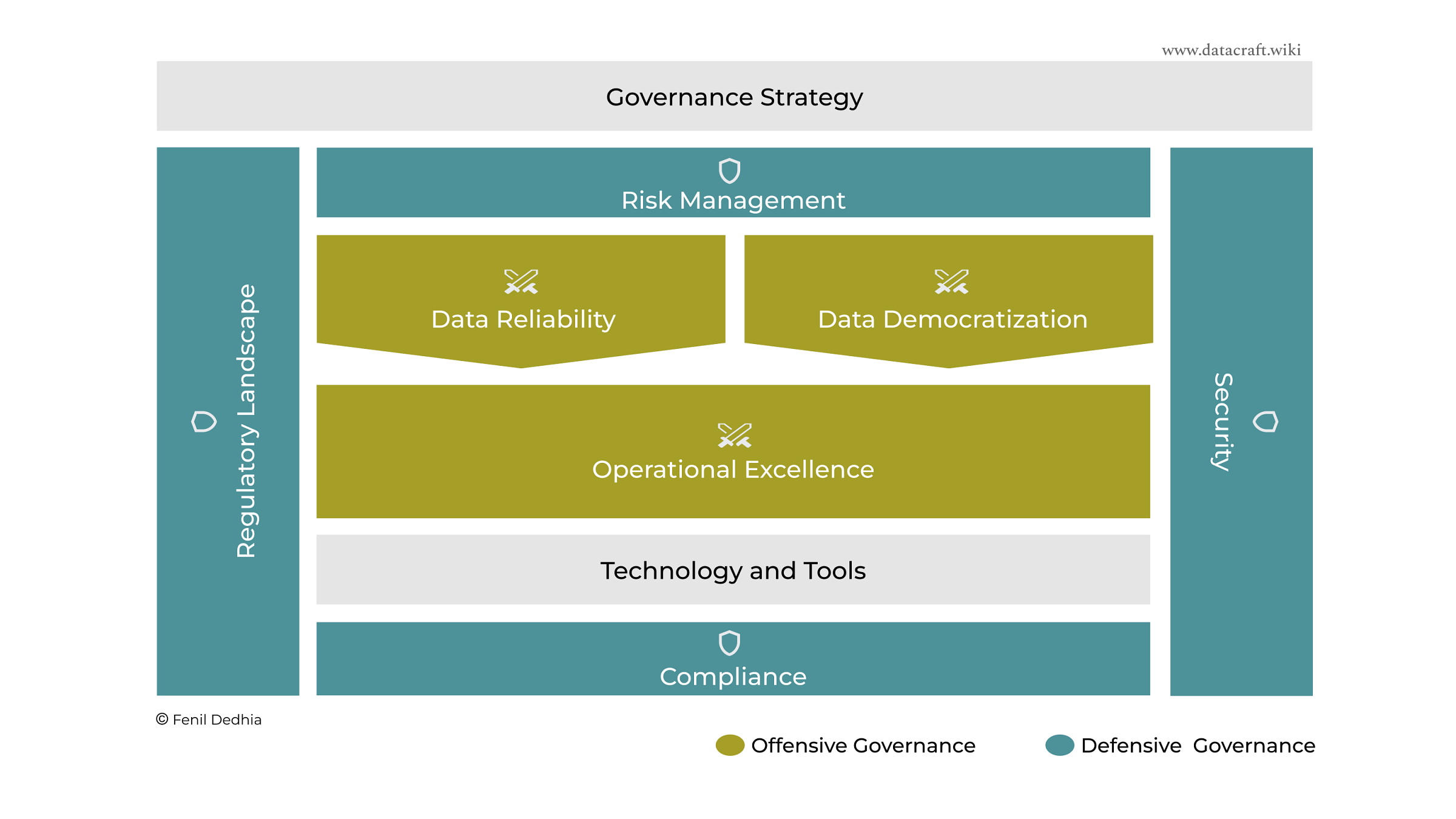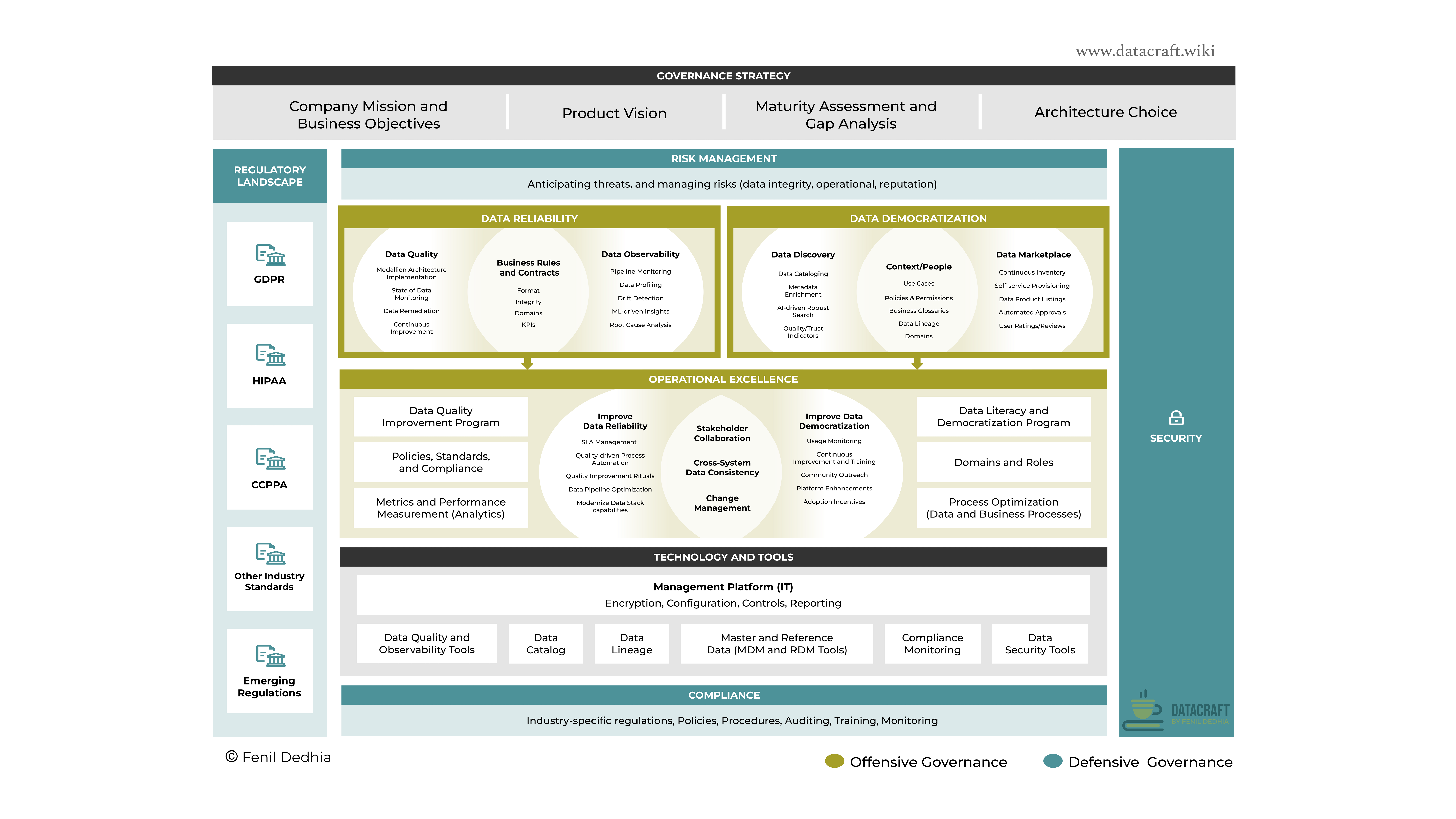The Definitive Guide to Implementing Data Governance
Breaking down modern data governance into a practical, actionable framework that adapts to your organization's maturity level and unique challenges.
I spent over 3 months finding and studying the best data governance resources, and reading up the implementation stories and case studies found on popular data management forums, slack communities, and even Reddit and LinkedIn.
And one thing was very clear:
Most "how to" data governance resources fail at the implementation stage.
Why?
Because they were built for a different era. Traditional frameworks like DAMA-DMBOK and DGI's Data Governance Framework suffer from critical limitations.
They emerged when data lived in centralized data warehouses, when regulatory pressures were the primary drivers, and when risk management concerns trumped value creation through data enablement.
Today's data ecosystem demands something different.
This is why if you've tried implementing data governance before, you've likely faced one or more of these challenges:
Resistance from teams who see governance as bureaucracy rather than enablement
Difficulty measuring and demonstrating tangible value of data governance
Frameworks that collapse under real-world complexity
Technology that promises solutions but creates new problems (low/negative ROI)
This guide takes a practical approach.
If you want to start implementing data governance in your organization, this resource is for you.
Building on our previous discussions about the rise of modern data governance and the offensive-defensive governance forces, we're now moving from theory to practice.
Let’s start with the bottom line, upfront.
Executive Summary: Implementing Modern Data Governance
If you're looking to build effective governance in your organization, here are the key principles to guide your journey:
Core Principles of Modern Data Governance:
Balance value creation (offensive) with value protection (defensive)
Align governance directly with business objectives and product goals
Start small with high-value domains, then scale methodically
Build governance into workflows rather than imposing it as a separate process
Measure success through business outcomes, not governance activities
Getting Started - Your First 90 Days:
First 30 days: Measure your current state, identify 1-2 high priority domains, establish initial roles
Days 31-60: Implement basic quality monitoring, enhance discovery capabilities, develop essential policies
Days 61-90: Measure improvements, expand to additional domains, refine based on feedback
The Framework at a Glance:
Our framework consists of three interconnected layers that build upon your existing technology:
Foundation: Strategic alignment with business objectives and product vision
Offensive Governance: Data reliability, data democratization, and operational excellence
Defensive Governance: Compliance, security, and risk management
Throughout this guide, you'll learn how to customize this framework for your specific organizational context and maturity level.
Remember: effective governance isn't built overnight! It's an evolving practice that grows with your organization.
How to Use This Guide
This guide is designed to be useful whether you're just learning about data governance or actively implementing it in your organization. Here's how to navigate this content and find the most relevant starting points for your specific needs.
For Different Reader Journeys
If you're exploring data governance concepts:
Start with the sections "Executive Summary" and "The Modern Data Governance Framework: An Overview"
Focus on understanding the balance between offensive and defensive governance. The Part 2 of this series might be particular helpful: Balancing a Data Governance Strategy: The Defensive-Offensive Framework
If you're implementing governance now:
Use the Data Governance Implementation Navigator below to identify your starting point
If you're enhancing existing governance:
Focus on balancing offensive and defensive capabilities. Use the Data Governance Implementation Navigator below to identify a starting point
Read the "Building the Tech Foundation: Choosing the Right Toolkit for Governance" section to evaluate your current tools
🌟 Data Governance Implementation Navigator: Start Here
Use this decision tree to identify where to focus your governance efforts first:
Step 1: What's your primary motivation?
Regulatory pressure → Start with "Value Protection: Managing Risks and Enforcing Regulatory Compliance"
Data reliability → Start with "Value Creation: Enforce Business Rules through Data Quality and Observability"
Data literacy and democratization → Start with "Democratization: Making Data Work for Everyone"
Optimizing governance operations → Start with "Operational Excellence: Optimizing Regular Governance Operations"
Building data foundation → Start with “Building Your Foundation: Aligning Governance with Business Strategy"
Step 2: What's your organization's data maturity?
Early stage (undefined data practices, limited tooling) → Focus on basic documentation, core quality rules, and essential access controls
Growing (some practices established, inconsistent application) → Implement domain ownership, standard quality metrics, and self-service discovery
Mature (established practices, seeking optimization) → Focus on integration across domains, advanced quality automation, and enhanced democratization
Step 3: What resources do you have available?
Limited (part-time roles, minimal budget) → Begin with high-value quick wins that require minimal investment
Moderate (dedicated roles, some budget) → Implement a balanced approach across offensive and defensive capabilities
Substantial (dedicated team, significant budget) → Build comprehensive capabilities with advanced tooling
Step 4: Which domain should you tackle first? Choose a domain that is:
High-value to the business
Experiencing painful data issues
Has engaged stakeholders
Manageable scope
Common domains to start with include customer data, product data, or financial data, depending on your specific business priorities.
Moving Beyond Traditional Frameworks: What Actually Works
Traditional frameworks like DAMA-DMBOK, DCAM, and DGI's Data Governance Framework suffer from critical limitations:
Rigid processes with centralization bias: They prescribe fixed processes instead of adaptive approaches. They assume centralized control when today's reality is distributed data ownership
Compliance-first mentality: They prioritize risk management over value creation
Technology lag: They don't account for modern data stack capabilities. They focus on structured data when most organizations now manage complex, multi-modal data (think data lakes and lake houses)
How can you tell if a framework will work for your context?
Ask yourself:
"Does this framework acknowledge the reality of how my organization actually works?"
Evaluation criteria for selecting the right approach
When evaluating governance frameworks, look for these qualities:
Business alignment: Connects governance activities to your specific business objectives
Balance: Addresses both offensive (value-creating) and defensive (value-protecting, risk-mitigating) needs
Adaptability: Allows customization to fit your organizational structure and culture. It should offer different implementation paths based on your current capabilities. Modern data governance must be adaptive by design.
The most effective frameworks don't prescribe specific solutions but provide decision frameworks that help you make the right choices for your context.
Reality? Data governance is never "done." It's an ongoing effort that evolves with your organization.
The Modern Data Governance Framework: An Overview
Establishing a clear framework early on is critical. It clarifies what data governance is and what it is not, helping to avoid confusion, set expectations, and drive adoption.
The framework we’re about to explore addresses both the defensive aspects of governance (compliance, security, risk management) and the offensive elements (data reliability, data democratization, operational excellence) that create tangible business value.
The framework is simple. At its core,
Defensive Data Governance protects business value.
Offensive Data Governance creates business value.
The framework consists of three interconnected layers:
The Foundation
Strategic Governance Inputs: The foundation that aligns governance with business goals
Technology Toolkit: The framework sits atop a technology layer that provides the tools and infrastructure to implement the required capabilities effectively.
Offensive Data Governance
Data Reliability:Enables trust and usage of data
Data Democratization: Makes data accessible to all appropriate stakeholders
Operational Excellence: Optimizes day-to-day practices that sustain governance
Defensive Data Governance
Compliance: Monitors the regulatory landscape and ensure meeting compliance standards.
Security: The foundation of protection - implementing controls, managing access, and safeguarding data throughout its lifecycle. While compliance tells you what to protect, security determines how to protect it.
Risk Management: Beyond immediate security concerns, this involves anticipating threats, managing vulnerabilities, and maintaining data integrity across the organization.
Each layer contains specific capabilities and activities that organizations develop according to their maturity level and needs.
The framework deliberately incorporates both offensive and defensive forces, building on the balance we explored in depth in our previous guide on the offensive-defensive framework. For specific strategies on calibrating this balance for your organization's unique context, refer back to that resource.
Feeling Overwhelmed? You're Closer Than You Think!
Most organizations already have foundational elements of governance in place, even if they don't call it "data governance." Look for these existing capabilities you can build upon:
Documentation: Product specs, API documentation, and data dictionaries
Quality checks: Validation rules in applications, data pipeline tests
Access controls: User permissions, role-based security
Data ownership: Tribal knowledge of who manages key systems
Instead of building from scratch, inventory these existing capabilities and formalize them within your governance framework. This approach can accelerate implementation and can increase adoption by building on familiar practices.
In the following sections, we'll explore each layer of the framework in detail, with practical guidance on implementation.
Building Your Foundation: Aligning Governance with Business Strategy
Effective governance doesn't start with policies or tools - it starts with strategy.
The foundational layer of the framework ensures your governance efforts address the right problems and delivers the right value for your specific context.
Step 1: Aligning with company mission and business objectives
Generic governance programs fail. Full stop.
Your governance approach must explicitly connect to your organization's strategic priorities. Here are four things to quickly document first:
Keep reading with a 7-day free trial
Subscribe to Datacraft to keep reading this post and get 7 days of free access to the full post archives.




